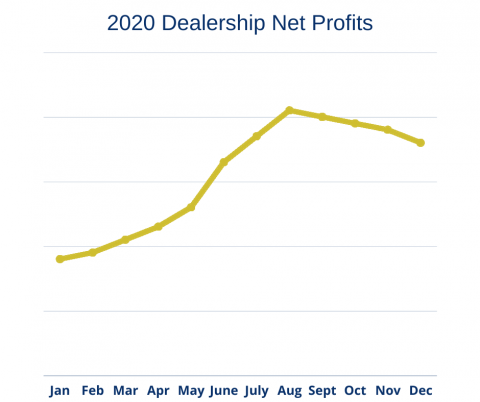The "Covid Bounce" Continues

So here we are…2021. We finally made it out of 2020! Does that mean the auto biz will get better? Well for the auto industry, business has been on an upswing for months. Let’s face it. This country is driven by the auto industry. Our successes (and failures) foretell what the economy as a whole can expect. Yes third quarter sales in 2020 were down 10% from 2019, but it’s a huge improvement from the 34% drop in Q2.
We’ve been calling it the “Covid bounce.” After severely diminished sales early in the year due to dealership shutdowns and reduced buyer confidence, a bounceback was expected as dealers filled the gaping need for vehicles, but it hasn’t stopped. It’s months later, and we’re still seeing strong sales numbers. Vehicle inventory is getting gobbled up as people abandon planes, trains, and public transportation, opting to own their own vehicles.
As new and used vehicle inventory shortages will likely continue through mid-March, per-vehicle retail grosses have been double the pre-Covid numbers. Plants are not yet operating at full capacity, exacerbated by parts supplier shortages, there still remains a significant demand to be met.
With postponed lease turn-ins, reduced trade-in volume and bans on repossessions, quality used vehicles became a hot commodity, especially as many consumers who want a new car are either getting priced out or can’t get what they want, moving them into pre-owned options, as we’ve discussed in other recent communications. Used car wholesale prices are where retail used to be. The average list price on cars less than 10 years old has increased by more than 9%.
Trillions of dollars have been pumped into the economy over the past 8 months, and most recently billions more were added by the Federal Government. We predict it is likely that between further stimulus money and the upcoming tax returns, auto sales and prices will continue at their elevated levels Some industry experts claim that the auto business will reach a balance by the end of Q1, but as stated above, parts shortages continue to be an issue. Now we’re seeing a possible microchip shortage.
Blue sky values are close to the highest levels ever recorded, which we’ve seen through the many buy-sells that have taken place over the past few months. Cutting costs by reducing ad spend (opting to monopolize efforts on social media), minimizing floor plan (as finance rates have hovered at record lows), and reducing staff because of the increased internet sales (some as much as 30-to-40%) have all contributed to a large profit increases upwards of 50 percent. Blue sky multiples are an estimated 0.5x higher than they were this time last year.
Two additional recently adopted sales methods helping to boost sales and profits are increased digitization and a more personalized approach to the car-buying process. Shifting sales online is a concept more and more consumers want, not just during a pandemic, and dealers are embracing it. Companies like Carvana and Vroom wouldn’t exist if there wasn’t a desire for their services. Carmax now has joined the mix with a very high concentration on internet sales. In fact, 18% of shoppers say they would buy a vehicle sooner if they had an online purchase option. Many dealers are selling cars completely online, giving virtual walk-arounds, completing the all-important F&I process digitally and delivering vehicles to customers or setting appointments for them to pick up their vehicles.
As part of the more personalized approach, customer service has been the center of all consumer-driven innovation over the past 5-10 years, making BDCs increasingly important. Consumers can go to any dealership, so the level of service and the increased personalized methods (never want to use this awkward term!) have been what makes the buyers decide where to buy. More use of a digitized process and providing home delivery shows that a dealer is willing to literally go the extra mile for its customers. Same goes for drop-off and pick-up for service appointments.
These days, personalized sales are more about collecting data, allowing dealers to know their customers inside and out. Tracking software tells retailers what cars a customer is searching for before he or she even submits a lead form. From there, most “personalization” communication can be automated - phone calls, emails and texts sent out automatically. For example, a customer gets a satisfaction survey 3 days after the purchase and a follow-up call 7 days later. Even service reminders can be sent out in a text message. Include a link to schedule online. Tell them a lot porter will pick up their car at their chosen date and time. Many dealers were already using these approaches pre-Covid, but now they’re more important than ever.
There are many factors fueling the Covid bounce, but most of them have and will continue to systematically change the way the auto industry and dealers function moving forward, not just in 2021 but forever. Most importantly though, this bounce has reminded us, as did the 2008 crash, that we can deal with a crisis and always remain resilient, evolving into ever stronger dealers






